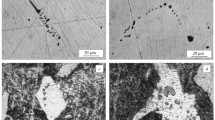Conclusions
-
1.
After tempering at 550–650° the cold resistance of steels microalloyed with vanadium decreases considerably. In selecting steels for structures subject to impact loads at low temperatures it is necessary to take into consideration the heating of elements in the process of manufacture and maintenance.
-
2.
The cold brittleness of steel 12KhGFD after treatment at tempering temperature can be eliminated by heat treatment.
Similar content being viewed by others
Literature cited
L. M. Utevskii, Temper Brittleness of Steel [in Russian], Metallurgizdat, Moscow (1961), p. 191.
T. A. Vladimirskii, Brittleness of Steels [in Russian], Mashgiz, Moscow (1959), p. 232.
O. A. Bakshi, A. I. Monoshkov, and A. G. Kukin, “Method of determining the components of fracture toughness,” Zavod. Lab., No. 5, 615 (1969).
É. É. Blyum et al., “Effect of heat treatment on cold brittleness of new low-alloy steels,” in: Transactions of the Ural Wood Technology Institute [in Russian], No. 29, Sverdlovsk (1973), p. 28.
Additional information
All-Union Scientific-Research Institute of Railroad Transportation. Translated from Metallovedenie i Termicheskaya Obrabotka Metallov, No. 9, pp. 27–28, September, 1979.
Rights and permissions
About this article
Cite this article
Kotel'nikov, V.L. Effect of tempering on the cold resistance of steels 15GFD and 12KhGFD. Met Sci Heat Treat 21, 689–691 (1979). https://doi.org/10.1007/BF00708631
Issue Date:
DOI: https://doi.org/10.1007/BF00708631



